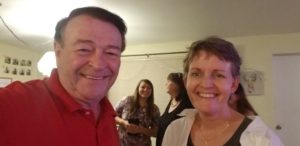
Lori Conser with Wynn Thompson
I’ve dreamed of writing a book since I was a skinny little sixth grader in 1975. That was the year I fell madly in love with reading.
But now, forty-three years later, I still haven’t accomplished that dream.
Over the last fourteen years, I’ve worked at Wheatmark and watched author after author fulfill their dreams of seeing their written words turned into books for publication. It’s been an inspiration.
And I’ve realized that dreams don’t just get handed to you. You have to pursue them and diligently work at them.
So when Wynn Thompson, an elder in my church, told me he was struggling to write his autobiography, I realized that this could be my chance. Wynn has an amazing story, and I’ve always wanted to try my hand at ghostwriting. So I took the plunge and volunteered to ghostwrite it for him. He was elated. This was an answer to prayer, he said.
And thus it began—a novice’s adventures in ghostwriting.
I knew from my past experiences as a newspaper reporter that the first thing I needed to do was learn his full story. So I downloaded a recording app onto my phone and started interviewing Wynn in two-hour sessions once a week. Because Wynn is quite a talker, it took several months for me to get his whole story—and we chased more than a few rabbits. Transcribing all these recordings to notes on paper was brutal—each transcribing session taking twice as long as each interview.
But once this was done, I read through all the transcribed material and knew I had the makings of a good story. But how would I organize it? What would I keep? What would I let go? At first I thought about ordering the plot in some cool way, like using a scene from later in his life to propel him back to the past, then to the present, then to the past again…
But let’s face it, tenses can get super tricky when you write like that, and I didn’t want to make this more complicated than I could handle. So I decided to keep it simple…at least for the first draft.
Next, I organized a rough outline of all my chapters, and the characters and settings that I was going to use for the first part of the book. This is called story boarding, and I’m still working through my own version of it. I found an app that helps called Trello, which has simplified the process.
The trickiest part in this whole process has been finding enough time to write. Because I work full time and my job requires that I sit at a computer all day, it’s nearly impossible for me to even look at a computer when I get home. So I carved out an hour each morning—from 5:30 to 6:30 —that can only be used for writing Wynn’s book. It’s been working pretty well so far. Morning is definitely the best time for me to write because my mind is fresh. True, having a two-hour block of time would be even better. But that would mean compromising on other morning commitments—something I’m not willing to do.
So now I’m in the writing phase of the project—finally! Every time I complete a chapter, I send it to Wynn with questions like, “What did your house look like?” or “Can you think of a particular scene that shows how your mom and dad interacted with each other?”
Wynn is eager to fill in the details, and we’ve become quite the team. He also modifies each area where my imagination goes haywire, then sends the updated version back to me for more rewriting and editing.
The best part about this whole project is that Wynn’s counting on me. His excitement and expectations help to keep me steady and faithful; I don’t want to let him down.
And God willing, step by step, we will see this through to publication.
Thanks for the inspiration!
